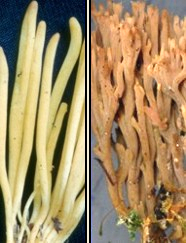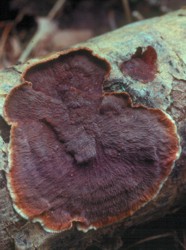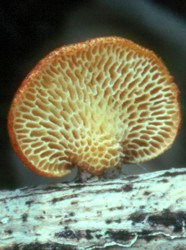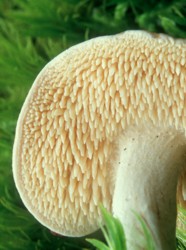DISCUSSION OF NON-GILLED MACROFUNGI
Members of the Agaricomycetes that are not mushrooms or boletes are exceedingly common and diverse. Anyone observing fungi in the field will come across them but will often have difficulty in identifying them using popular field guides. The traditional way to classify these fungi has been based on the shape of their fruiting bodies and the nature of the surfaces bearing their basidia and basidiospores. While these means of recognizing them are useful to the naturalist they do not reflect the true genetic relationships of these organisms. Of course the most accurate way to determine relationships among them is to use advanced molecular genetic tools. When these are not available a microscope will yield most of the information necessary to do the job, although this requires some skill and patience.
As with other groups of fungi we will take the rather outdated but intuitive approach and present the members of this group according to the appearance of their fruiting bodies. Within each of these artificial groups we have attempted to comment upon what mycologists believe are their true relationships. Listed below are four catagories:

Club- and coral fungi
The club and coral fungi produce their basidiospores along the surface of smooth or slightly wrinkled "fingers". The fruiting bodies are always upright and have a radial symmetry similar to that of plants. Organisms with radial symmetry have an inside and an outside but not matching sides. Humans have bilateral symmetry and have two nearly identical halves while plants have radial symmetry and can never be divided into two matching halves. The individual fingers of club- and coral fungi are unbranched in the club fungi and branched in the coral fungi. There are some intermediate forms that are sometimes branched and sometimes not but this is not usually a problem for identification. Members of this group range in size from almost microscopic to very large and massive.

Corticioid and stereoid fungi
Members of this group are probably the most difficult to distinguish of all the non-gilled fungi. They do not have radial symmetry and usually have a recognizable front and back. The corticioid fungi are those that grow flat down on their substrate, a condition called "resupinate". They are usually found on wood and produce basidia and basidiospores over an exposed and nearly smooth surface. Punctularia strigoso-zonata in the picture at left is fairly typical of this type. Stereoid fungi also have nearly smooth spore-bearing surfaces but with these raised up from the substrate either by turning away from it at the edges of the fruiting body as the one in the picture is doing or by producing a mushroom-like stipe (stalk).

Pore fungi
The pore fungi may be resupinate (lying flat on the substrate), reflexed (forming a bracket) or stipitate (raised on a stalk). All produce their basidia and basidiospores on the inside surface of tubes. These "polypores" are among the most common fungi growing on wood of standing or fallen trees and are just as abundant in northern forests as they are in the tropics.

Tooth fungi
Like the pore fungi the tooth fungi can be resupinate, reflexed or stipitate. The basidia and basidiospores are borne on the surface of little teeth that cover one side of the fruiting body. The best-known of the tooth fungi is Hydnum repandum, figured at left. It gives its name to the alternate term for tooth fungi, the "hydnoid" fungi.